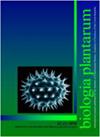寒地冬小麦扩增蛋白TaEXPA9同源基因的克隆与功能分析
IF 0.9
4区 生物学
Q4 PLANT SCIENCES
引用次数: 0
摘要
背景低温是影响冬小麦安全越冬能力的重要因素。过低的气温限制了冬小麦的再生,从而降低了农业产量。据报道,与植物生长有关的非酶膨胀蛋白对干旱、盐度和低温胁迫有反应。我们从具有高抗寒性的冬小麦“东农冬小麦2号”的转录组分析中获得了一个由低温诱导的膨胀蛋白基因TaEXPA9,但该基因的表达模式和功能尚不清楚。因此,我们分析了TaEXPA9-A/B/D在D2中的表达模式,以响应不同器官中不同的非生物胁迫和外源植物激素处理。获得了TaEXPA9-A/B/D的全长,并使用绿色荧光标记对TaEXPA9-A/B/D在洋葱表皮上的亚细胞定位分析。构建了35S::TaEXPA9-A/B/D表达载体,获得了过表达的转基因拟南芥系,以检测该膨胀蛋白的同源物对植物生长和低温胁迫抗性的影响。结果TaEXPA9-A/B/D转录在4°C低温胁迫下显著增加,其在根中的表达水平较高,且TaEXPA9-A/B/D定位于细胞壁。过表达的拟南芥根系发育良好,生长相关标记物和结实率均优于野生型。霜冻胁迫后,过表达植物的恢复能力更强。在4°C低温胁迫下,TaEXPA9-A/B/D过表达的拟南芥植物的抗氧化酶活性和渗透调节物质含量显著高于野生型植物,膜脂过氧化程度较低。结论TaEXPA9-A/B/D参与低温应激反应,并可能通过保护酶系统增加对低温应激引起的活性氧的清除。此外,TaEXPA9-A/B/D可以提高小分子有机物质的水平,以抵抗低温引起的渗透胁迫。本文章由计算机程序翻译,如有差异,请以英文原文为准。
Cloning and Functional Analysis of Expansin TaEXPA9 Homologs in Winter Wheat in Frigid Regions
BackgroundLow temperature is an important factor that influences the ability of winter wheat to safely overwinter. Excessive low temperatures restrict the regrowth of winter wheat, thus decreasing agricultural output. Non-enzymatic expansins, which are related to plant growth, have been reported to respond to drought, salinity, and low temperature stress. We obtained an expansin gene, TaEXPA9, that is induced by low temperature from a transcriptome analysis of ‘Dongnong winter wheat no. 2’—a winter wheat with high cold hardiness—but the expression pattern and function of this gene were unknown. We therefore analyzed the expression patterns of TaEXPA9-A/B/D in D2 in response to different abiotic stresses and exogenous phytohormone treatments in different organs. The entire length of TaEXPA9-A/B/D was obtained, and green fluorescent labeling was used for subcellular localization analysis of TaEXPA9-A/B/D on onion epidermis. The 35S::TaEXPA9-A/B/D expression vector was constructed, and an overexpression transgenic Arabidopsis thaliana line was obtained to examine the effects of the homologs of this expansin on plant growth and low temperature stress resistance. ResultsThe results showed that TaEXPA9-A/B/D transcription significantly increased at 4°C low temperature stress, its expression level was higher in the roots, and TaEXPA9-A/B/D was localized to the cell wall. The roots were well-developed in the overexpression A. thaliana, and the growth-related markers and setting rate were better than in the wild-type. Recovery was stronger in the overexpression plants after frost stress. At 4°C low temperature stress, the antioxidant enzyme activity and osmoregulatory substance content in the TaEXPA9-A/B/D-overexpressing A. thaliana plants were significantly higher than in the wild-type plants, and the degree of membrane lipid peroxidation was lower. ConclusionsIn summary, TaEXPA9-A/B/D participates in the low-temperature stress response and may increase the scavenging of reactive oxygen species caused by low temperature stress through the protective enzyme system. Additionally, TaEXPA9-A/B/D can increase the levels of small molecular organic substances to resist osmotic stress caused by low temperature.
求助全文
通过发布文献求助,成功后即可免费获取论文全文。
去求助
来源期刊

Biologia Plantarum
生物-植物科学
CiteScore
2.80
自引率
0.00%
发文量
28
审稿时长
3.3 months
期刊介绍:
BIOLOGIA PLANTARUM is an international journal for experimental botany. It publishes original scientific papers and brief communications, reviews on specialized topics, and book reviews in plant physiology, plant biochemistry and biophysics, physiological anatomy, ecophysiology, genetics, molecular biology, cell biology, evolution, and pathophysiology. All papers should contribute substantially to the current level of plant science and combine originality with a potential general interest. The journal focuses on model and crop plants, as well as on under-investigated species.
 求助内容:
求助内容: 应助结果提醒方式:
应助结果提醒方式:


